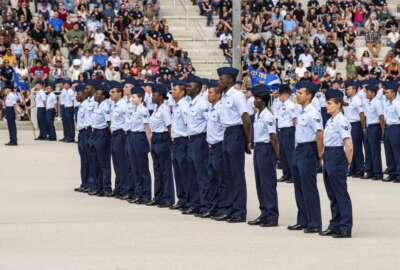As the nation marked the 75th anniversary of desegregation in the military and the federal workforce, it celebrated progress — but the occasion also served as a reckoning. A combination of congressional concerns about quotas and recruiting problems for the armed services reveals a fault line in how the military should set policies to increase diversity.
“I think we as a nation have always been three steps forward, two steps back. And every time there is a movement toward equal rights, there has been a countermovement for that,” retired Army Brig. Gen. Ty Seidule, who served as the vice chairman of the Congressional Naming Commission, which renamed DoD bases honoring Confederates, told Federal News Network. “Whether it’s after Reconstruction, or it’s the reaction to the civil rights movement, or the reaction to a black president, or the reaction to the call for equal justice after George Floyd.”
Seidule, who served 36 years in the Army and wrote the book “Robert E. Lee and Me: A Southerner’s Reckoning with the Myth of the Lost Cause, said the backlash against diversity comes from a few loud members of Congress who don’t represent the majority opinion.
New data laid bare the concerns of racial minorities in the military. A study by military family advocacy group Blue Star Families found that 38 percent of military families of color feared for their safety because of discrimination in the communities where they live.
Anicia Myers, the coordinator for the Campaign for Inclusion at Blue Star Families, said those safety concerns also create a reluctance to serve or stay in the military for service members who identify as racial minorities. While her organization’s 2022 study found families reported less discrimination in the military than in their civilian communities, the problems exist in both places.
“A lot of the issues that are happening with isolation and a lack of belonging in the community have to do with the fact that many families experienced pushback — many families do not feel safe. Many families are sitting around the dinner table discussing whether or not they are going to stay active duty,” Meyers told Federal News Network.
The Air Force, Army and Navy expect to see a shortfall of about 10 percent in their recruiting goals this year and to fix that, service leaders believe they need to be more inclusive.
“I don’t think I know of a time where the military is more understanding that they have to make sure there’s equal opportunity for all because that’s where the force is. If you’re going to fix this recruiting crisis, you’re going to have to go after marginalized communities – that’s the only way we’re going to fix it,” Seidule said.
Congress took steps to counter discrimination in the military with the fiscal 2021 National Defense Authorization Act (NDAA), which included the creation of the DoD chief diversity officer position and an advisor for diversity and inclusion within each military department.
In a March 2023 House Armed Services Committee (HASC) hearing on diversity, equity and inclusion, Gil Cisneros, the now outgoing undersecretary of defense for personnel and readiness, raised concerns like those in the Campaign for Inclusion report.
“The concerns young Americans have about safety are negatively impacting recruiting. If a recruit or service member does not feel safe reporting to work for fear of discrimination, that is a problem we must address for the individual, for the military and for the success of the department’s mission,” Cisneros said.
However, some Republican members of Congress say efforts toward diversity, equity and inclusion (DEI) policies have gone too far. The House version of the 2024 NDAA includes three amendments to defund diversity efforts at the Pentagon.
The amendments include language that “Prohibit federal funds for training on diversity, equity and inclusion,” “Prohibit federal funds from being used to establish a position within the Department of Defense for anything similar to chief diversity officers or senior advisors for diversity and inclusion” and “Eliminate any offices of only — diversity, equity and inclusion along with the personnel in said offices.”
The Senate version of the 2024 NDAA supports DEI, and while Seidule said the House amendments seem unlikely to make it into the final defense authorization bill, other efforts also attempt to limit DEI.
Service academies under fire
One way to speed underrepresented groups into positions of authority over the years was by having them graduate from service academies. But even that approach is coming under fire.
At a HASC personnel subcommittee hearing on the service academies on July 19, the superintendents of the three service academies faced pointed questions about affirmative action policies.
“I believe race-based admissions, in any form, violate the Constitution and the military service academies must ensure immutable characteristics like race, like color, have no bearing on a candidate’s ability to tackle the rigors of the military service academy,” Rep. Jim Banks (R-Ind.) said at the hearing.
Banks also wrote an amendment incorporated into the House 2024 NDAA to prohibit funding for “military service academies to discriminate on the basis of race or ethnicity in academy admissions or to establish quotas for admission based on race or ethnicity.”
A Supreme Court decision in June rejecting race-conscious admissions policies at universities excluded the military academies from the ruling.
At the DEI hearing, Cisneros said about 40% of the DoD, both civilian and uniformed, identifies as a member of a racial minority.
A study last September by the Carnegie Endowment for International Peace found African Americans made up 19% of active-duty enlistments but only nine percent of active-duty officers. At a higher rank, only 6.5% of general officers identified as black.
Seidule, a professor emeritus of history at West Point, said diversifying the officer corps requires getting women and minorities into the academies and officer training programs. He said the academies are pushing for more diversity, and that West Point has a higher percentage of black students than that of Ivy League colleges.
However, there are signs of progress.
“In the last 20 years, the female population at the Naval Academy has doubled. The ratio of diversity at the Naval Academy over the last 10 to 15 years has increased,” Vice. Adm. Sean Buck, superintendent of the Naval Academy said at the House hearing on the academies.
Since President Harry Truman wrote executive order 9981 desegregating the military, the Pentagon has a black Secretary of Defense in Lloyd Austin and a future black Chairman of the Joint Chiefs of Staff if Air Force General C.Q. Brown is confirmed by the Senate. In the last 10 years, combat roles opened up for women.
“We are the most diverse force in the world, and therefore we’re the most successful. Do we want to be like the Russians? No, of course not. We want to reflect that diversity. And that’s our great strength,” Seidule said.
Nearly Useless Factoid
By Michele Sandiford
Barbie and Ken broke up in 2004.
Source: The Washington Post
Copyright
© 2024 Federal News Network. All rights reserved. This website is not intended for users located within the European Economic Area.






